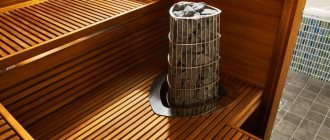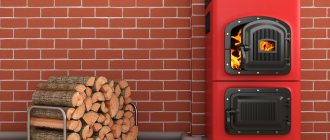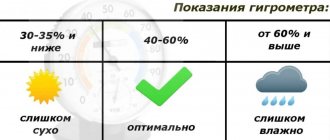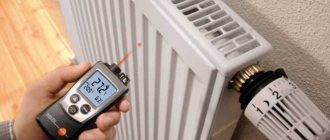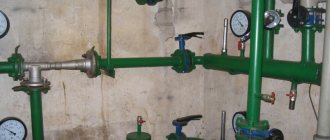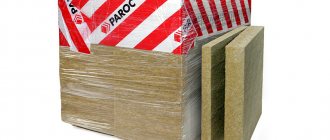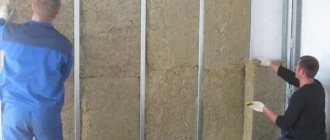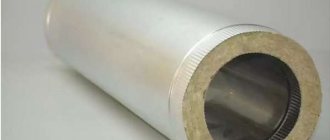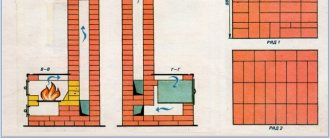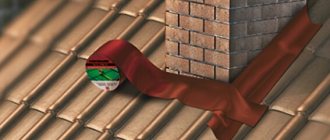How high should a chimney pipe be in a private house?
The first and main requirement for a chimney is safety. To a large extent, this factor depends on the height of the chimney pipe and its location relative to other communications. To protect yourself and your household from the penetration of combustion products into living spaces, you must strictly follow the rules for the selection, installation and use of chimneys.
The height of the chimney is an important parameter for the normal functioning of the entire heating system
Basic rules for any type of pipe
There are parameters for the selection and installation of chimneys, both common to all systems and specific to a particular type of pipe, furnace and boiler. First of all, you need to study the axioms that are relevant for each chimney.
The main ones among them are the following:
- The chimney should not be higher than the adjacent ventilation duct. Otherwise, combustion products will enter the house.
- The height of the boiler room chimney must be at least 5 meters. The ideal parameters are 6 or more meters from the grate to the mouth of the firebox (the height of the weather vane does not count).
- The height of the chimney above the roof of the building must be at least 500 mm. Otherwise, traction may deteriorate.
- The internal space of the chimney must comply with fire safety standards: the cross-section of the pipe must be calculated by a specialist, in accordance with the technical documentation of heating devices and SNIP standards. The cross-sectional parameters of a square chimney should be proportional to the dimensions of the firebox in a ratio of 1:1.5. (for a fireplace 1:10 of the size of the firebox). The diameter of the boiler room chimney pipe must be no less than the diameter of the blower.
- If the height of the chimney above the ridge level exceeds 1.2 m, it must be reinforced with guy wires.
Helpful advice ! The key parameter is not only the height of the chimney of a boiler room for a private house, but also the type of heating device. For each of them there is an optimal type of pipe. A cylindrical chimney has the best aerodynamic properties. If you need to connect several devices into one chimney channel, it is better to use an industrial version of the pipe.
The chimney must be securely fastened and, if necessary, braces are used for this.
It is better not to use clay for the interior decoration of boiler room pipes, as this entails the formation of condensation and a decrease in draft.
Chimney - fundamental design
Today we will talk about how to correctly calculate a chimney.
When designing and building a chimney for a house or bathhouse, it is important to choose the right material from which it will be built (see Chimney pipes). It is necessary to know exactly what fuel will be used in heating appliances. After all, chimney pipes designed to work with one type of fuel are completely unsuitable for working with another.
As an example - a brick chimney. Brick pipes work great with wood fuel, but are completely unsuitable for working with gas-powered heating devices.
It is important to choose the correct height and diameter of the chimney, its cross-section . The wrong choice of one of these parameters will, at a minimum, affect the quality of traction and the efficiency of the heating system, and, at a maximum, can lead to dire consequences. Let's figure out how to calculate the height of the chimney. If one heating device is used with the chimney, the issue can be resolved by simply reviewing the technical documentation provided by the manufacturer. But when several different heating appliances are simultaneously connected to one smoke exhaust system, then in order to calculate the chimney, a solid knowledge of thermodynamics, material properties and much more is required. That is, a professional engineering calculation will be required, even if the chimney is being built not for residential premises, but for a bathhouse.
Therefore, amateurism in this matter can be costly for a careless “designer”.
Universal chimney - reality and myth
As previously mentioned, the basis of any chimney is the material from which it is made. Many manufacturers of modern chimney systems often advertise their chimney pipes as universal, capable of operation under any conditions, with any type of fuel. We can say with absolute certainty that such systems do not exist.
There are, of course, chimney systems that work well in certain connection options and on different fuels. But you should understand that they work well - this does not mean that they meet all the parameters that distinguish a high-quality chimney from just a chimney.
Internal section of the chimney - which is better
The optimal shape of the chimney is a cylinder. When the chimney is operating, the walls are not heated evenly. Because of this, combustion products move upward in the chimney with twisting along the central axis.
Naturally, a cylinder is the most acceptable form for this if we want to get strong traction.
- If rectangular pipes are used, then turbulences are formed in the corners, preventing normal traction. But let’s make a reservation: vortices are formed, first of all, from the thrust speed itself. Thus, the higher the thrust speed, the greater the turbulence and the greater the resistance to the normal process of gas movement in a rectangular pipe.
- From this it becomes clear that a rectangular chimney can be successfully used with heating appliances that do not require large drafts. This has only a positive effect on the operation of wood-burning fireplaces and stoves; this option is also suitable for the construction of a wood-burning sauna.
- For example, if the smoke circulation in a stove or fireplace is not properly arranged, a rectangular chimney will significantly save heat, unlike a chimney with a round cross-section, from which it will, as they say, “fly out into the chimney.”
- As for new generation boilers, it is better to use cylindrical pipes. Typically, such boilers operate on the stop-start principle.
- The main savings when using these boilers depend on the heating rate of the heating system. The faster the system warms up to the desired temperature, the faster the boiler will turn off and go into standby mode and, accordingly, save.
- In order for the boiler to warm up faster, in addition to fuel, it needs a good flow of fresh air. The air flow is created due to draft; accordingly, the greater the draft, the better the boiler works and the faster the heating system warms up (see How to improve draft).
Accordingly, the best option for such boilers would be a cylindrical chimney.
What should be the internal diameter of the chimney?
Many people wonder how to calculate the chimney diameter for various heating devices. Here we can say the following - read the manufacturers' instructions. If instructions are missing, you can use this recommendation:
Our advice: calculating the diameter of the chimney for a fireplace with an open firebox or for a wood-burning sauna stove is done as follows. The ratio is 1:10 , in relation to the firebox. This applies to cylindrical pipes.
The calculation of the cross-section of a square chimney is determined in proportion to the size of the firebox 1:1.5 . The diameter of the stove chimney pipe should not be less than the diameter of the blower.
If the heat transfer is less than 300 kcal/hour , the cross-section should be 140×140 mm , no less. The correct choice of chimney diameter is the key to successful operation of the heating system as a whole.
Chimney height - calculation and reality
But if you have figured out the cross-section of the chimney, the next question arises - what should be its height?
There is no clear answer here either. To understand how to calculate the correct chimney height, it is necessary to take into account many factors.
Warm air tends to rise. As it leaves the chimney, it cools down. Accordingly, the longer the air remains in the chimney, the higher its temperature. This means that more air will tend to rise, creating thrust.
Consequently, the larger the volume of the chimney, the more warm air tends upward and the greater the amount of draft. But the volume of the chimney increases not only due to its height, but also due to the size of the internal section.
Suppose there is a cylindrical chimney 5 m high in the bathhouse. To obtain maximum draft values, we increased its internal diameter. According to the above, the volume of warm air in the chimney has increased, and the draft should increase.
But no. Due to the large internal diameter, combustion products cool quickly.
It's like pouring hot tea from a cup into a saucer. Condensation forms on the walls of the chimney, preventing normal smoke outflow. The result is loss of traction.
Let's reduce the internal diameter of the chimney and increase its height. Logically, the volume of warm air increases, it cools more slowly, and the draft should be good.
Indeed, the traction will be good. And even too much. Strong cravings will literally throw your money away. A strong influx of fresh, cold air into the boiler furnace will reduce the efficiency of the heating device; it will take more time to warm up the heating system, which means the boiler will consume more fuel. As a result, one can only dream of saving.
If the height of the chimney is too high and the internal diameter is too small, the draft may deteriorate. This happens due to aerodynamic resistance in the chimney pipe. As a result, carbon monoxide will enter the room.
Here is an example of incorrect calculations in the design and construction of chimneys.
- The scheme for calculating the height of the chimney is also interpreted by certain rules and technical characteristics of the materials and the building itself.
- You can calculate the height of the chimney pipe using available special programs. If the chimney pipe is lower or at the level of the ridge, a turbulence will form at the outlet, and this is bad.
- The height of the chimney above the roof must be within strictly established parameters.
- The height of the chimney above the ridge directly depends on the distance at which the chimney is located relative to the vertical line of the ridge. If the chimney is located at a distance of less than 1.5 m, the minimum height of the chimney above the ridge should be 500 mm .
- Accordingly, if it is further from the vertical line of the ridge, its height is adjusted. At a distance of 1.5-3 m, the chimney can be flush with the ridge.
Help - in any case, the minimum height of the chimney above the slope of the roof of a bathhouse or other room should not be less than 500 mm .
The height of the chimney above the roof
The height of the chimney pipe above the roof is calculated individually. The chimney height is calculated taking into account various parameters:
- roof slope angle;
- roof thickness;
- distance from the vertical axis of the ridge.
Help: calculating the height of the chimney does not take into account the height of the umbrella covering the chimney.
Parameters for maximum chimney efficiency
How high should chimney pipes be for heating appliances to function at maximum efficiency? The main rule is that the higher the pipe, the better the draft and efficiency of the furnace or boiler.
If the structure has a rectangular shape, then the aspect ratio of the section should be maintained at 1:1.5. But the corners of the section inside should be rounded. If the chimney pipe has the shape of a rectangle, its cross-sectional area should not be less than 10 sq cm. A round pipe cannot be less than 15 cm in diameter, and in the case of a chimney - 18 cm.
Important! It must be remembered that the height of the chimney above the roof must be clearly calculated with strict regard to fire safety standards. It is unacceptable to place the boiler room chimney in close proximity to windows, doors, or too low above the roof, since flying sparks can cause a fire.
On the one hand, the chimney designer must think about ensuring that the heating system transfers as much heat as possible to the room, but on the other hand, it is necessary to “leave” the smoke a sufficient temperature so that it removes all combustion products into the atmosphere as cleanly as possible, without leaving traces. on the walls of the chimney. In this case, the size of the pipe is of great importance; it must be selected correctly. A pipe that is too high and narrow can lead to increased aerodynamic drag and impaired traction. Too low and wide - the smoke will quickly cool and condensation will accumulate on the walls of the chimney. This will lead to rapid contamination with soot and, again, disruption of traction.
The chimney should be installed away from windows, doors and ventilation ducts
The minimum height of the chimney is allowed if its edge is located near the ridge. This installation option provides some advantage: the main trunk of the structure runs through the attic space and will be less subject to cooling, which reduces the likelihood of condensation settling and deterioration of draft.
Why are calculations needed?
Natural air exchange, in which combustion products are removed into the atmosphere, occurs only if the smoke exhaust structure has the correct shape and size.
If there are obstacles - turns, corners, sections of the smoke channel with low throughput - the smoke can go in a different direction, where nothing will interfere with its spread. If the chimney height is low, the temperature difference will be insufficient to generate draft, or wind pressure will appear, which will prevent the smoke from leaving the chimney, practically driving it back.
Note! Defects in the chimney design will lead to the fact that the draft will either be insufficient for the normal operation of the heating device, or a reverse draft will appear and fuel combustion products will flow into the premises, which can cause poisoning or a fire.
However, about the size of the chimney it cannot be said that the larger the better. A chimney that is too long or wide will increase the cost of chimney construction. A stove or boiler with such a chimney will wear out under conditions of excess draft, burning fuel faster than necessary to warm the premises. The heat obtained during combustion will partially fly away into the chimney, causing heating costs to increase.
We recommend that you read: Rules for installing stainless steel chimneys
Therefore, in order for the heating unit to work efficiently and not break down, it is important to accurately calculate the main parameters of the chimney, which will ensure the optimal level of draft.
Features of the pipe depending on the type of fuel and material of manufacture
Whatever type of raw material you use (gas, firewood, coal, fuel oil), any of them requires an individual approach to maximize the extraction of “warm” gigacalories, or more precisely, ensuring the optimal yield of combustion products. A chimney for a private home must ensure 100% combustion of fuel without excessive consumption. It must be strong and durable, easy to repair and clean.
Depending on what type of fuel material is used, the type of chimney is selected. For example, if you are going to burn with wood, a brick pipe would be your best option. The main thing is to choose the right fire-resistant material for masonry and insulation. Built according to all the rules, such a chimney perfectly accumulates heat.
However, there are certain disadvantages:
- Brick chimneys are large in weight and bulky. When installing them, additional requirements are imposed on the foundation of a building for private houses;
- the rough inner surface is prone to contamination, is often clogged with soot, and requires repair and cleaning;
- the use of other types of fuel material or the use of modern heating devices for the boiler room leads to condensation settling, which destroys the chimney;
- short service life. As practice shows, destructive processes in the chimney begin to occur after 2-5 years of operation.
Steel pipes are one of the best chimney options for modern stoves and boilers
Modular stainless steel chimney and other pipe options
Steel chimneys for boiler rooms are made from high quality steel by welding in an inert environment. Such chimneys have a structure called “sandwich”. Inside, the chimney is made of steel of a special composition, then there is a layer of heat-insulating material, and on top there is a protective layer of lower quality metal (usually galvanized or stainless steel is used).
It is important to know! Aisi steel is used in the manufacture of such chimneys for the home. This is a 300 series austenitic alloy and has a high level of acid resistance. Unlike this type of steel, the material of the four hundred series is less resistant to the negative effects of aggressive chemicals.
However, installation of such a structure is complicated. Installing it yourself at home can lead to unpleasant and even tragic consequences.
Types of sandwich pipes
In addition to stainless steel and galvanized steel, other materials are used to produce sandwich pipes for chimney structures. For example, ferrous metals are also in demand, but they are then coated with a protective layer of enamel. Such products can withstand operating temperatures up to +500̊ C and temperature changes up to +750̊ C. Read also: “Types of galvanized chimney pipes, their advantages and installation rules.”
By the way, finished stainless steel sandwich pipes are resistant to the destructive effects of corrosion and look quite presentable. If we talk about their resistance to high temperatures, they are significantly inferior to stainless steel devices. But, at the same time, chimneys made of ferrous metals are in demand in the production of fireplaces and stoves. This chimney is easy to install, durable and practical to maintain.
Another type of sandwich is a combined structure made of galvanized steel (enamel-coated) and stainless steel. Such chimneys can withstand temperatures of a maximum of 600°C.
How to independently calculate the diameter and height of the chimney, making the stove safe
I welcome my dear reader and bring to your attention an article on how to correctly calculate the chimney in your home.
The main component of comfort in the home is warmth. The owner of the house has to solve heating problems in a private house. For heating, small units are used that can be installed independently (except for gas ones), including chimneys.
To ensure complete removal of flue gases from the room, good draft and prevent draft overturning, it is necessary to comply with the requirements of regulatory documentation.
Why is a chimney calculation required?
It is the chimney that ensures the safety of residents. An improperly designed chimney is unable to completely remove toxic combustion products (carbon dioxide and carbon monoxide, sulfur oxides), smoke and soot. There can even be a fire if hot smoke enters the room. Particularly dangerous is the overturning of the draft - turning the movement of smoke in the opposite direction.
Therefore, when installing a chimney, it is necessary to correctly calculate its parameters - they ensure the creation of ideal draft and complete removal of harmful substances.
What parameters require calculation?
The main parameters of any vertical chimney are the length and internal (working) cross-section of the smoke exhaust duct. All the information below is equally true for heating appliances using any type of fuel, but the parameters of chimneys for gas boilers are calculated by specialists from a licensed design organization.
Length
The length of the chimney is determined by SP 7.13130.2013. Its length (or height) is measured from the head at the top of the pipe to the grate of the heating boiler. The standard provides for the minimum height of the chimney and the height of the head relative to the roof ridge.
It should be borne in mind that the height determined by calculations is nominal. In fact, the chimney of a modern boiler is located on the side, the boiler outlet is located in the upper part of the unit at a certain height relative to the bottom of the firebox. Therefore, the actual length of the vertical part of the chimney will be slightly less than the calculated data - the distance from the bottom of the firebox to the outlet pipe. This distance can be determined from the unit drawing or measured.
Don't think that extending the chimney is a good thing. The draft is based on the rise of hot exhaust gases, and if the pipe length is too long, the gases cool and the draft decreases. For the same reason, the chimney must be insulated. Even traditional red brick stove chimneys need insulation. The situation with draft is further aggravated by the fact that the exhaust gases from modern boilers with high efficiency have a low temperature.
With a moderately elongated chimney, the draft increases, and more heat escapes into the atmosphere. Too strong a current of gases will extinguish gas heating units. The draft can be adjusted using valves.
Installing a low chimney in a residential building is completely unacceptable - there is not enough vacuum in it, gases rise at a lower speed, which is why the draft decreases. It is allowed to install low chimneys on free-standing stoves, for example in a barbecue garden, etc.).
Chimney diameter
The diameter of the chimney is no less important for creating draft. When installing modern heating units, the minimum diameter is determined simply - according to the unit’s passport (and the diameter of the outlet pipe). In addition, the regulatory documents provide the minimum cross-sectional dimensions of chimneys corresponding to a unit of a certain power. These data are given in the unit passport.
If for some reason the internal cross-section of the chimney is chosen to be square, then its area should be no less than the circular structure.
When using an existing traditional stove, the chimney is left the same. When constructing a brick stove and chimney with your own hands, you must use the project (preferably not downloaded from the Internet!) and lay out the pipe in exact accordance with the drawing. The same applies to free-standing brick structures.
Rules for installing chimneys for gas boilers
In order for the system to have good traction, the following technical requirements must be observed when installing a structure made of double-circuit pipes:
- assembly is carried out from the heater;
- the smoke channel must be smooth;
- there should be no bends along the entire length of the chimney for a gas boiler;
- to have good traction, it must be at least five meters in height;
- two bends are allowed at an angle of 45 degrees and one at a right angle. Moreover, these segments should be no more than one meter;
- the structure must be rigid, for this it is attached to the wall at a certain distance;
- the umbrella should rise above the roof ridge by at least 50 cm;
- Do not neglect the installation of additional elements, such as a moisture accumulator, a purifier and a head.
The parts of the metal sandwich pipe are fastened with rivets at the joints. Additionally, you can put on a clamp to hide the fasteners. Where the structure passes through walls and ceilings, a metal screen is installed. This is a square sheet of tin with a round hole in the middle. Special heat-resistant wool is placed into the resulting void between the warm lining of the chimney and the ceiling material. It looks like mineral wool, and foil is glued to both sides.
Calculation methods
Professionals use several methods for calculating chimney parameters. When installing large industrial pipes, designers are tasked with very complex calculations. They take into account:
- quantity and composition of flue gases;
- concentration of harmful substances in combustion products;
- pipe material;
- roughness of the internal surface of the hog;
- meteorological situation in the region.
The calculation of large pipes often serves as a topic for a thesis at an institute. Fortunately, the size of chimneys in a private house is smaller, and the power of heating units is also inferior to industrial facilities.
When designing a small pipe for a private house, simpler, although quite accurate, calculations are used. The chimney parameters obtained as a result of calculations ensure complete evacuation of combustion products from the firebox and ensure the safety of residents. Such calculations allow you to avoid errors in choosing parameters and when installing the chimney, and to avoid subsequent reworking of structures. Such alterations in an already built and finished house are much more difficult than during the construction process.
When calculating the parameters of chimneys of a private house, exact and approximate (Swedish) calculation methods are used.
Exact method
For heating, ready-made industrial heating or heating and cooking units with a certain chimney diameter are often installed. With sauna heaters or oil stoves for garages, ready-made sandwich chimneys of small diameter (100 mm) are usually also installed.
How to correctly calculate chimney parameters
After the calculations, the height of the pipe is checked against the requirements of the regulatory document - it must be no lower than that required by SP 7.13130.2013. In any case, take a larger length value.
The best chimney diameter is the one corresponding to the heating unit’s passport.
Determining the height of the chimney
The height of the chimney is determined at the design stage of the house, depending on the location of the pipe on the roof, the distance to the ridge or to neighboring tall objects (houses, large trees).
Why is this parameter needed?
The draft depends on the height of the chimney, which means the reliability and safety of the heating unit and the safety of the residents of the house. If flue gases are not removed sufficiently, the efficiency of the boiler, stove or fireplace decreases, and there is a danger of poisoning residents with carbon monoxide or carbon monoxide and the danger of fire.
SNiP requirements
In accordance with SP 7.13130.2013, the minimum height of the smoke exhaust pipe from the head to the grate of the heating unit must be at least 5 m. When the pipe exits onto a flat roof, its height must be at least 0.5 m. The maximum length of the horizontal section should not exceed 1m.
To create the required vacuum when the chimney exits the roof, the height of the pipe head above the roof is also specified (see table below).
There is also the concept of wind support. If the chimney is located near a tall building, a tree, or a low free-standing chimney is located close to the house, then these objects can block the chimney from the wind and reduce draft. To determine whether the pipe does not fall into the wind pressure zone, it is necessary to draw an inclined line through the top point of the house or tree at an angle of 45° to the horizontal. The pipe head should be above this line.
Of the two height values, choose the larger one. If in order to comply with regulatory requirements it is necessary to build a very high chimney (much higher than 5 m), then you will have to install a smoke exhauster that provides sufficient draft for any length of the pipe.
Table of the height of the chimney above the ridge
The height of the chimney above the ridge must comply with SP 7.13130.2013. The information is given in the table:
| Distance to the ridge or parapet of the building, m | Pipe height relative to ridge level, m |
| Up to 1.5 | 0.5 m higher |
| Up to 3 m | flush with the ridge |
| More than 3 m | the angle between the line connecting the ridge with the tip and the horizontal should be no more than 10° |
The distance from the ridge to the pipe is measured strictly horizontally.
Calculation of the cross section of the smoke channel
SP 7.13130.2013 determines the minimum cross-sections of the chimney duct of a brick or concrete chimney depending on the power of the heating unit:
- up to 3.5 kW – 140×140 mm (Ø no less than 158 mm);
- 3.5-5.2 kW – 140×200 mm (Ø no less than 189 mm);
- 5.2-7.0 kW – 140×270 mm (Ø no less than 219 mm).
When upgrading stoves with unknown power, either leave the existing chimney section or insert a round stainless steel liner of suitable diameter inside. If modern ceramic or sandwich pipes are installed on an old furnace, then the internal diameter of the modules must be no less than the diameter of the liner that would fit when installed in the old pipe. Theoretically, you can look for a design for an old stove, but in most cases this is not possible.
Most often, a stove maker was invited, and he assembled stoves and chimneys of 2-3 mastered standard sizes without any designs or calculations. In reality, it is impossible to determine all the features of a brick stove by its appearance, and the only guideline when choosing the cross-section of a liner or a new chimney is the cross-section of the hog of a pre-existing chimney (provided that it worked well). If the chimney provided insufficient draft, then when replacing or modernizing it, it is better to invite a heating engineer and entrust him with the appropriate calculations.
The diameter of pipes with an internal surface made of smooth ceramics or stainless steel may be slightly smaller (by 30%). The valves of solid fuel furnaces must have an unobstructed hole with a cross-section of at least 15×15 mm.
Internal section of the chimney: which is better?
In a square or rectangular chimney, there will be smoke turbulence in the corners, slightly inhibiting the flow of gases and facilitating the settling of condensation and soot. For the same reason, the corners of the pipe practically do not participate in the flow of gases. In addition, square and rectangular hogs have a larger wall surface area than round hogs - this increases the friction of rising gases against the walls and slows them down more.
Types of products for chimneys
Currently, several versions of stainless steel smoke exhaust ducts are produced.
Pipe products are:
- corrugated;
- smooth single-walled;
- sandwich.
In terms of their structure, the first and last versions of the products are exclusively round in cross-section. Single-wall products can be oval or rectangular in shape.
Products with a rectangular shape are rarely used. They are designed for installation inside brick chimneys. In most cases, these products are manufactured only to order.
Chimney pipes are made from several types of metal.
The most popular steel grades are:
- AISI 304;
- AISI 310;
- AISI 316.
The first steel grade on the list is characterized by a high level of resistance to acids. It performs its function perfectly at temperatures up to two hundred and fifty degrees. When working with non-aggressive gases, this material can withstand temperatures up to six hundred degrees. In most cases, it is used to construct single-wall structures or sandwiches used to service low-temperature heating units.
AISI 310 is a heat-resistant steel grade. It can withstand heat up to a thousand degrees. At the same time, a pipe product made of this metal does not lose its shape. The acid resistance of this material is not very high. But it is suitable for installing chimneys intended for installing solid fuel boilers.
AISI 316 is the best steel grade. Various types of chimney ducts are made from this material. It has good acid resistance and high heat resistance. This grade of steel can withstand temperatures of nine hundred degrees. It can be used with any type of boiler.
Pipe products for arranging chimney ducts are often equipped with additional thermal insulation. This property is typical for pipes of all types discussed above. As a rule, manufacturers offer product options both without additional thermal insulation and with it. In the second case, its role is played by basalt fiber mats.
